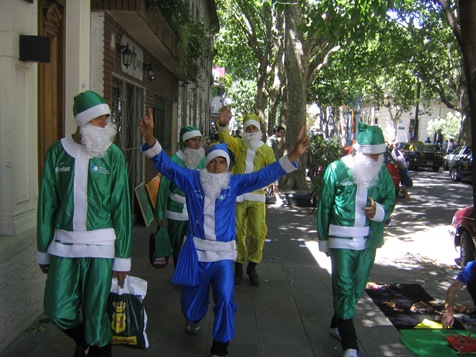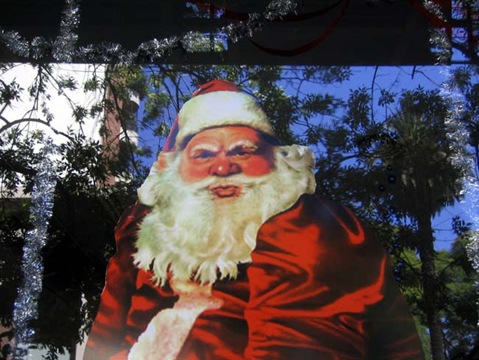 B
Buenos Aires is all about food. There are thousands of places to eat in Buenos Aires; over 700 in Palermo alone. In addition to the typical
parrilla (steak house), Buenos Aires boasts Italian, Spanish, French, Scandinavian, Asian, French, Mexican, Middle Eastern, Polish and German restaurants . . . and many others. If you like, you can dine on dinner prepared with aphrodisiacs. Not your cup of tea? How about vegetarian or macrobiotic restaurants? The variety seems endless; staggering really. Something for everyone and at every price point. One of the nice aspects is that unlike the nonsense we experience in the states (i.e. liquor license that is expensive and difficult to get), you can get a beer, a glass of wine, or something stronger at virtually at any restaurant; even a tiny empanada shop or even a café.
Breakfast: Breakfast like we have in the U.S. is unheard of. It's all about pastries and coffee; or a sandwich. No eggs, sausage or bacon & hash browns!
Media lunas are commonly eaten for breakfast. They are essentially a brioche shaped in the form of a crescent, like a croissant, and glazed. Oh, and about the coffee. They don't have coffee like in the U.S. either. Coffee is essentially espresso. I always order café doble (otherwise it's really a small portion) and Carolyn orders a
café doble con leche (double size coffee with milk) or
café cortado (espresso with a little milk). Cream is not used in coffee either. In fact, we could not find that they have cream at all. They use milk or steamed milk.
The café: The café is a “
porteño”
institution
(porteño =
people of the port). When we think of cafes, we usually think of Europe, but the porteños are real experts. Cafés abound everywhere and people sit in them for hours. Somehow, they have made a science of nursing an espresso for two hours. And we have fallen for it head over heels. Carolyn and I routinely wile away two hours or more, people watching in between reading magazines, blabbing and sipping. You will notice a wonderful tradition in cafes: The waiter will nearly always serve a small cookie with a cup of coffee.

Meat: Argentina has the highest per capita meat consumption in the world. Once you have a steak here, you will know why. The beef in better restaurants is outstanding. The cattle from which better beef is had graze on the pampas and eat actual grass, so the taste is better and the meat leaner. I have had tenderloin that literally tastes like it's melting in my mouth. Be aware that Argentina butchers cut up the beef into slightly different cuts, so some are similar to what you will find in the grocery store in Chicago; others are not.
My favorite cuts of beef:
bife de lomo (or simply
lomo) = tenderloin
bife de chorizo = similar to top loin, sirloin steak, strip steak, N.Y. strip
ojo de bife or
bife ancho = rib-eye cuts
bife con lomo = T-bone (or Porterhouse) steak
Note:
lomito is a smaller serving of
bife de lomo, typically a thin serving on a sandwich. At Pinot Cafe, a neighborhood restaurant at Plaza Guemes, near Casa Palermo, I order a sandwich called "
Lomito Especial," which is very tasty, topped with cheese and a fried egg.
Note 2:
Chorizo is a grilled sausage that can be found in every parrilla. It's got to be really, really bad for you, but I can't resist them; succulent and delicious. One of the best
chorizos I've had is at
La Dorita de enfrente. (note: Argentine chorizo is very different and nothing like Mexican chorizo).
Parrilla (pronounced pah-reesh-ah): A parrilla is a steak house and they are ubiquitous in Buenos Aires. Typically, an enormous grill is the centerpiece of the restaurant. Parrillas serve all varieties of beef,
sausages, chinchulines (small intestines), riñones (kidneys) and morcilla (blood sausage).
 Where to eat?
Where to eat? To find restaurants in Buenos Aires,
Óleo is the best guide available, short of personal recommendations. The Óleo database allows searches by a variety parameters: cuisine, neighborhood, price, etc. Not only will it provide the address and usually a photo of the restaurant, it will provide a location map. Particularly helpful are the ratings of the food, service, decor and price that are calculated by user votes. Indeed, vote after you've eaten someplace. Óleo is indispensable.
Gael Greene's "
Buenos Aires Hot List" is noteworthy and Ms. Greene's credential's are impeccable. However, Casa Palermo guests receive our person list of recommendations. Recent guest Tom B. from Venice, Florida wrote, "
The restaurant recommendations were amazing. While some were more enjoyable than others, there was not a bad meal to be had from your list." One of our recent favorites is the restaurant
Bo Bo (at the Bo Bo Hotel) in Palermo.
Hours: Porteños dine later than people of the U.S. Dinner in restaurants begins at 9:00 p.m. and people take their time. Restaurants don't turn tables (except in some touristy restaurants; principally in Puerto Madero). Once you have a table, take your time and feel free to stick around until the place closes.
Pizza: There are loads of pizza places in BA. The pizza is a bit different that in the U.S., but terrific. Among our favorite's is Morelia.
Order the pizza "a la parrilla" (grilled) and you will find yourself drooling over a thin, cracker crisp pizza. Indoor and outdoor seating.
Smoking: Buenos Aires went smoke free in January, 2007. No smoking in any restaurants. However, this has raised the popularity of outdoor seats.
Mate: You will notice people drinking and sharing mate. Mate is essentially a tea made with the dried leaves of a plant called yerba mate. Typically it's drunk from a gourd through a special metal straw called a bombilla. Mate is something that is enjoyed in someone's home or shop. It is not sold in cafes or restaurants.
 Home made
Home made: There are many family operated restaurants in Buenos Aires. You won't find them in Recoleta or Barrio Norte, but they are hiding all over the other barrios. These places often look run down but serve excellent, truly home made food. Don't be afraid to try them.
Tips:
- Don't bother cooking at home: There are too many wonderful restaurants to try.
- Tipping: For excellent service, tip 10%. Average service: 5 - 7%.
- Tips: Be prepared. For some odd reason, you cannot add a tip to a credit card charge. You must leave the tip in cash, so come prepared!
- Reservations: Some restaurants don't accept reservations; many do. If you don't show up within 15 minutes of your time, don't be surprized if they give your table to another guest.
- Wine: Initially we ordered expensive wines, but a local friend taught us to stick to wines in the $20-35 Peso range. These are almost all excellent. No need to spend $60 or $80 Pesos unless you really want to splurge.
- Beer: Share by ordering "la cervesa grande" and ask for "dos vasos" (two glasses).
- Payment: Be prepared, some places only take cash. Only some places will accept U.S. dollars.
- Pepper: You will find salt on the table, but rarely pepper. Ask pimienta, por favor (pee myen tah)
- Hot: Forgettaboutit. Oddly, hot and spicy (picante) are not popular. We have found it difficult to find anything real spicy. Carolyn spotted Tabasco recently, only to discover it labeled "MILD" (!).
- Chimichurri: It's not spicy. It's got flavor and served with meat, but it's not spicy.
- Casera (kah-ser-ah): This means "home made" and is often a sign of good eating.
- Water: Virtually all restaurants serve bottled water, either sparkling (agua con gas) or still (agua sin gas), however, we regularly drink tap water at Casa Palermo.
- Picadas: Not all restaurant have these, but if they do, they are great to have instead of a meal. Picadas are simply a plate of tidbits. Usually cubes or slices of cheese, ham, olives, etc.
- A punto (ah poon-toh): Cooked medium (steak = pink)
- Cruda (crude-ah): Rare (as in very under-cooked), bloody center.
- Well done: I don't know (this shouldn't be done to beef unless you like it tough).
- Dulce de Leche (duel-say deh lech-eh): Caramel. People are crazy about it in Buenos Aires.
- Milanesa: beef, pork or chicken in a thick covering of bread crumbs.
- You want to sit outside? Ask "afuera, por favor." (Inside? Adentro.)



























